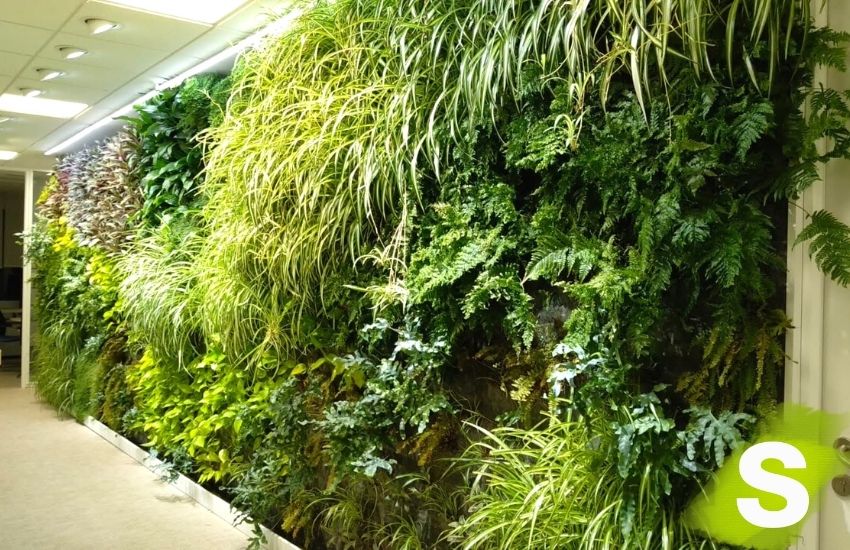Indoor vertical gardening allows us to create green areas in places where available space is scarce.
One of the easiest ways to make an indoor vertical garden is our F+P system (of course), but before we get into it, if you want to know the differences between indoor and outdoor vertical gardens you can take a look at our complete tutorial on the types of vertical gardening.

Indoor vertical gardens are a trend, and although it is also common to see artificial walls or plant paintings, we will always defend a good natural green wall.
Benefits of indoor plants
A multitude of studies have shown that plants balance humidity and room temperature, decontaminate, purify and improve air quality, and even help relieve stress.
There are many ways to make a natural indoor garden, always varying:
- The substrate
- The type of substrate
- The vegetation
Next we are going to explain how to build what we consider to be the best system for indoor vertical gardens.
It is a very simple system and a widely used material. In fact, most of the existing gardens are made of this type of substrate, geotextile.
We have evolved this technique to make our F+P system.
In this video we tell you all about this system for indoor vertical gardens.
Composition of the F+P vertical garden
The F+P system is composed of:
- A support strip using metal profiles that generates an air chamber at the back.
It is very important that these profiles are made of aluminium because it is a self-protecting material when it oxidises, so there is no corrosion or subsequent structural failure. If we use other types of profiles, such as galvanised steel, we expose ourselves to the risk of it degrading over time and causing serious problems in the structure.
- SG-P10 panel:
A 10mm thick plastic panel capable of generating a watertight and impermeable layer, preventing water from passing through it and reaching the back wall. In addition, this SG-P10 panel allows to screw or staple the SG-M500 geotextile substrate in which the plants are installed.
- Substrate SG-M500:
It is the geotextile that we use as a substrate where the plants grow, it is not a simple receptacle where we place some plants, it is expressly designed so that the plant species can develop in it and grow.
Functions of the SG-M500 substrate:
- Retains water
- Drains
These two functions may seem contradictory but they are actually the ones that make it possible for the plant to live, generating the optimum aeration for the plant roots to develop, grow, absorb nutrients and exchange the necessary gases.
Composition of the SG-M500 substrate:
This SG-M500 substrate is manufactured especially for vertical gardening and is composed of a double layer sewn in such a way that when installing it we only have to make a cut in the textile and place it between the two layers.
These two layers contain a series of fibres that are responsible for carrying out the most important functions of the substrate:
- Grey fibres: these fibres retain hardly any water, i.e. they are responsible for draining the vertical garden.
- Fibras de colores: son las encargadas de retener el agua.
4. Irrigation System SG-A24:
Hydroponic irrigation system adapted to the scale of the interior vertical garden, with automated control of irrigation and fertilisation.
Irrigation of the wall is achieved via the dual SG-R16 pipe system, with integrated self-compensating drippers and a lower channel for water collection.
At SingularGreen, we recommend the installation of remote control and management elements for the irrigation system in all our F+P vertical gardens, regardless of the surface area.
For interior vertical gardens with surfaces greater than 20 m², we consider it essential.
This way, we always have up-to-date information on the current irrigation status and its history, which is fundamental for the proper functioning of the vertical garden.
5. Vegetation:
Indoor plants specifically selected for each project by SingularGreen’s technical team.
Depending on the client’s needs and requests, as well as other factors to consider, we choose the best species for each vertical garden.
Installation of the F+P System Indoors
The installation process for this system is as follows:
- Screwing metal battens onto the wall to create an air chamber, which serves as our anti-moisture system and ensures trouble-free operation with water.
2. Screwing the SG-P10 panel to the battens using stainless steel screws.
3.Sealing the joints to create a continuous waterproof layer and prevent water leaks.
4. Placement of SG-M500 substrate over the SG-P10 panel using stainless steel staples.
5. Installation of the SG-A24 irrigation system and SG-R16 pipes for watering the wall.
6.Cutting the fabric according to the desired plant density for the vertical garden to create pockets.
- Remove the substrate from the plant, leaving the plant bare-root, to replace it with UG-MS10 substrate, specially selected for vertical gardening and to have greater durability.
- Planting, placing the plant in the pockets and stapling around it to fix it in position.
Plants installed in indoor vertical gardens
Some of the most common varieties that we usually install in indoor vertical gardens, in particular in the F+P system, are the following:
- Monstera deliciosa – Monstera
- Nephrolepis cordifolia “Duffii” – Curly sword fern
- Philodendron scandens – Philodendron
- Phlebodium areum “Blue star” – Blue star fern
- Pteris quadriaurita “Tricolor fern”
- Spathiphyllum wallisii – Spathiphyllum
All these plants are perfectly adapted to indoor situations, as their own characteristics mean that they do not require much fertilisation.
Their light requirements are low and in nature they tend to establish themselves in vertical or almost vertical environments, such as branches and tree trunks, always under a tree canopy, that is, in the shade and protected from direct sunlight.
Here is an article about 5 different types of ferns for vertical gardens.
Lighting for indoor vertical gardens
All indoor vertical gardens need artificial lighting.
Plants need a minimum daily amount of light to be able to carry out the processes of photosynthesis and cellular respiration, in short and to reduce the matter a lot, we can almost say that plants ‘eat light’.
It is important to have an independent and programmable light point for the installation of the necessary lighting for indoor vertical gardens.
The optimal lighting requirements and the characteristics of the light are explained in more detail in this article: ‘Lighting for indoor vertical gardens’.
Maintenance of indoor vertical gardens with the F+P system
The maintenance of F+P vertical gardens is not complicated, as indoor plants work very well in the system and do not usually need a lot of attention.
Maintaining this type of plants requires little work because they normally have very low nutrient requirements, as they need practically no fertiliser and with occasional work the garden can function perfectly.
In addition, thanks to the SG-A24 irrigation system, with which we automate the watering and fertilising of the vertical garden, this process is very convenient and requires practically no attention.
For the maintenance of indoor vertical gardens we recommend following these steps:
- Complete visual inspection of the vertical garden on a monthly basis.
- Visual control of the irrigation system: Check that there are no areas with dry plants on a monthly basis.
- Tactile verification of the irrigation operation: Check that the humidity of the SG-M500 substrate is adequate for the development of the plants on a monthly basis.
- Control and cleaning of the lower collection channel for the removal of dry leaves, avoiding blockages in the water outlet on a monthly basis.
- Removal of dry leaves in the vertical garden on a monthly basis.
- Light pruning of excess growth on a monthly basis.
- Visual control of pests and treatments if any on a monthly basis.
- Checking the level of the hydroponics tank of the SG-A24 irrigation system on a monthly basis.
- Major pruning 1 or 2 times a year, depending on the plant species.
- Replacement of weeds, if any.
- Complete cleaning and adjustment of the SG-A24P irrigation system on an annual basis.
- Annual reinforcement of fungi and beneficial bacteria for the vertical garden.
Why is the F+P indoor vertical garden better than substrate gardens?
The fact that the plant develops in the SG-M500 substrate and does not develop in the substrate that surrounds the root is very important for the durability of the vertical garden, as the geotextile we use has a very long durability.
This is because the SG-M500 substrate is composed mostly of synthetic fibres, a large part of which is polyester, and is therefore stable, as its composition does not change, nor its drainage capacity, nor its capacity to retain water, important characteristics to ensure the durability of the vertical garden.
If the substrate function is carried out by the potting soil in a geotextile pocket, i.e. a system of pockets filled with substrate or a textile substrate container, what happens is that this substrate degrades and washes away over time.
In addition, we will have problems of salt retention, in the case of watering with low quality water or if we fertilise with irrigation water.
This accumulation of salts can lead to a situation in which the substrate is no longer suitable for the plants to grow or even harmful to them and we would have to change the vertical garden.
This is one of the reasons why we made our indoor vertical garden F+P with SG-M500 geotextile as substrate.
Each vertical garden is a different case, so there is a system that adapts specifically to the needs of each occasion.
At SingularGreen we specialise in selecting the best option for each situation. If you have any queries, please do not hesitate to contact us.
Technical information for indoor vertical gardens
If you would like more technical information about the F+P system you can download it from our download portal.
Training
In addition, if you are interested in learning about vertical gardening, we have online training where you will learn about the different gardening systems on the market, the benefits of these vertical gardens and much more.







